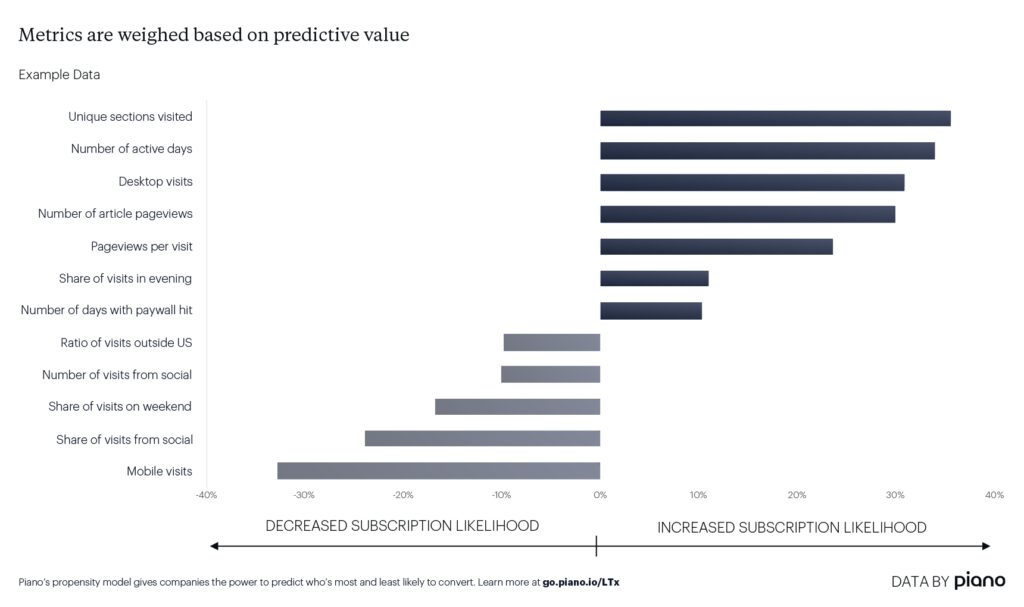Has AI Brought an End to the Metered Paywall?: Saying Good-Bye to the “Magic” Meter Number
This article, by Piano CEO Trevor Kaufman, was originally published on June 11, 2019 as part of the International News Media Association’s "Satisfying Audiences" blog, under the title “Has AI brought an end to the metered paywall?”.
Media companies, building out their subscription strategies and setting their metered paywalls, have grappled with finding the exact right balance of free pageviews and stopping users’ access for years — trying to determine the best way to maximize the balance of advertising and circulation revenue.
Of course, there is no magic number. Piano has seen visitors subscribe after a single pageview. Others take much longer to make the decision to convert, while some aren’t likely to ever subscribe at all. And those individual user-level differences vary based on a huge host of variables, whether that be geography, content consumption, visit behavior, subject matter, device, or a wide array of other metrics.
But what would happen if media providers didn’t need to define a meter by a single number, or even determine a specific path to lead visitors to their subscription offerings? What if, instead, they generated the optimal rules for each user in real time? And if they could target high-value offers to those most likely to respond, and guest passes or registration to those that need more nurturing along the way?
Predicting Outcomes
We’ve always believed that any rule set that can be expressed numerically in our tools could be best optimized by site-by-site machine learning models. Of course, the computer will never decide to run a back-to-school promotion, and there will always be a role for savvy marketing tactics. But anything that can be expressed purely numerically can probably be better optimized by a site-by-site machine learning model.
For about a year, we have been refining and testing our set of propensity models, which we are now unveiling as LT[x] (for “Likelihood To” act). A machine learning system, it sifts through every bit of browser-level data available to our clients to predict, and enables us to drive, user behavior. The first LT[x] model — LTs — predicts users’ likelihood To subscribe.
Here’s how it works. Through our relationship with companies across the globe, Piano has had the opportunity to analyze hundreds of subscription sites and billions of monthly user interactions. That unique vantage point has given us insight into what drives subscriptions — but more than that, it’s given us the data needed to see exactly what factors contribute to a user’s likelihood to subscribe.
Fueling LTs, then, is our understanding that certain data points correlate with a user’s chances of converting. Factors like the time of day or week users visit your site, or the device they visit on — to name a few — regularly form predictable patterns that demonstrate how users will eventually act. It doesn’t happen in a consistent way across sites and audiences, though: for one company, for instance, how a visitor arrives at their pages will play the most important role, and whether users are engaging with a wide array of sections and authors will be integral as well — for another site, those will be less reliable predictors.
So how do companies figure out which data points are the most important in predicting subscriptions on their site? They don’t. In fact, doing so would be so cost and resource intensive, it wouldn’t be feasible — the breadth of data involved is too expansive. But a custom algorithm can sort through that data for you, across all identified behaviors, to determine which are key to your subscribers. By doing so, LTs can rate each user, scoring them based on their likelihood to subscribe. And through machine learning, it automatically adjusts for each individual site and audience.
Dynamic Paywalls and Beyond
So what do we at Piano think this means for our customers, and the industry as a whole?
For us, paywall rules are examples of what we think of generically as “new business” — a world in which pricing and business rules are entirely dynamic and customized for each user. While a lot has been made of the “subscription economy,” we think the shift is bigger than whether someone pays once or on a recurring basis. There is an entirely new world coming in which everything about a business can react in real-time to a user and a business opportunity.
That’s the vision for the future that we’re all working towards, but already, LT[x] is generating more subscribers and more revenue for our clients. Soon, individual price optimization and even creative changes will be able to be optimized automatically by artificially intelligent functions like this one.
Today may be the death of the meter, but it’s the beginning of a new age of smarter, more satisfying automation.






